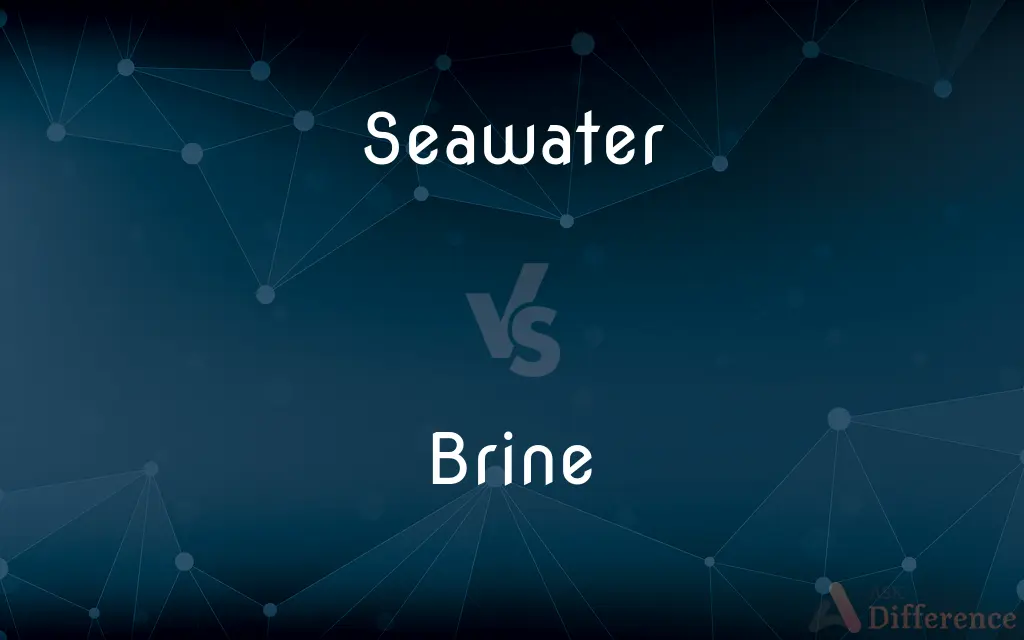Seawater vs. Brine — What's the Difference?
By Fiza Rafique & Urooj Arif — Updated on February 29, 2024
Seawater is the salty water found in oceans and seas, naturally occurring with a salinity of about 3.5%, while brine is a highly concentrated solution of salt in water, used in various industrial, culinary, and preservation processes.

Difference Between Seawater and Brine
Table of Contents
ADVERTISEMENT
Key Differences
Seawater and brine, although both saline solutions, differ primarily in their salt concentration and applications. Seawater, omnipresent in oceans and seas, has a consistent salinity due to the dissolution of mineral salts, primarily sodium chloride, along with other minerals. It supports marine ecosystems and influences global climate patterns through its physical and chemical properties. Brine, on the other hand, is a man-made solution with a salt concentration much higher than that of seawater, often exceeding 5% and used specifically for processes like food preservation, chemical manufacturing, and as a refrigeration fluid in some cooling systems.
The natural occurrence of seawater contrasts with the intentional creation of brine for specific uses. While seawater's composition and salinity are relatively stable, influenced by geographical location and depth, brine's salt concentration can be adjusted according to its intended application, ranging from culinary recipes to industrial processes. This flexibility in salt concentration makes brine versatile but distinctly different from the natural composition of seawater.
Seawater plays a crucial role in supporting marine life, acting as a habitat for countless species and influencing weather patterns and climate change. Brine, however, is primarily utilized for its physical and chemical properties in human activities, with its ecological impact considered in terms of disposal and environmental management, especially due to its potential to harm ecosystems if not properly handled.
Brine is used to enhance flavor and preserve food, leveraging its high salt concentration to inhibit bacterial growth and improve texture. Seawater, while not directly used in cooking, influences the flavor profile of marine foods and can be mimicked in culinary practices by adding sea salt to freshwater to create artificial seawater, especially for preparing seafood dishes.
Both seawater and brine are saline solutions, their differences in salt concentration, origin, applications, and ecological roles highlight the diversity of saline water's uses and characteristics. Seawater's natural balance is crucial for marine ecosystems and climate, whereas brine's utility spans culinary, industrial, and preservation domains, demonstrating human ingenuity in leveraging natural compounds.
ADVERTISEMENT
Comparison Chart
Salt Concentration
About 3.5%
Typically >5%, can be much higher
Origin
Natural occurrence in oceans and seas
Man-made solution for specific uses
Primary Uses
Supports marine life, navigation, climate research
Food preservation, culinary, industrial processes, refrigeration
Ecological Impact
Fundamental to marine ecosystems
Must be managed to prevent environmental harm
Flexibility
Salinity varies slightly but is generally stable
Salt concentration adjusted for specific applications
Culinary Application
Not directly used, influences marine food flavor
Used to preserve and enhance flavor of foods
Role in Climate
Influences global climate patterns
No direct role in climate
Environmental Management
Natural balance maintained through global processes
Requires careful disposal or recycling to avoid ecosystem damage
Compare with Definitions
Seawater
Used in desalination processes.
Seawater is converted into freshwater through desalination.
Brine
Acts as a refrigerant.
Brine is used in some cooling systems for its low freezing point.
Seawater
Supports marine ecosystems.
Coral reefs thrive in warm, shallow seawater.
Brine
Highly concentrated salt solution.
Brine is used to cure meats.
Seawater
Influences climate.
Seawater's heat capacity moderates global climate.
Brine
Used in food preservation.
Cucumbers are pickled in brine to make pickles.
Seawater
Salty water from oceans and seas.
Seawater covers about 71% of Earth's surface.
Brine
Plays a role in industrial processes.
Brine solutions are used in chemical manufacturing.
Seawater
Varies in salinity.
Seawater near the equator is less salty than in the mid-latitudes.
Brine
Adjusted for specific uses.
The salt concentration in brine is tailored to the preservation process.
Seawater
Seawater, or salt water, is water from a sea or ocean. On average, seawater in the world's oceans has a salinity of about 3.5% (35 g/l, 35 ppt, 600 mM).
Brine
Brine is a high-concentration solution of salt (NaCl) in water (H2O). In diverse contexts, brine may refer to the salt solutions ranging from about 3.5% (a typical concentration of seawater, on the lower end of that of solutions used for brining foods) up to about 26% (a typical saturated solution, depending on temperature).
Seawater
The salt water in or coming from the sea or ocean.
Brine
Water saturated with or containing large amounts of a salt, especially sodium chloride.
Seawater
The saltwater of a sea or ocean.
Brine
The water of a sea or an ocean.
Seawater
(not comparable) Consisting of seawater.
The continual seawater splashes corroded our equipment
Brine
A large body of salt water.
Seawater
(not comparable) Associated in some way with seawater, or intended for dealing with seawater.
The sharks in the aquarium had to be kept in a seawater tank
Aboard the ship we needed seawater soap for washing our clothes
Though it was a nuisance to arrange them, we found the seawater showers very refreshing
Brine
Salt water used for preserving and pickling foods.
Seawater
Water containing salts;
The water in the ocean is all saltwater
Brine
To immerse, preserve, or pickle in salt water.
Brine
Salt water; water saturated or strongly impregnated with salt; a salt-and-water solution for pickling.
Do you want a can of tuna in oil or in brine?
Brine
The sea or ocean; the water of the sea.
Brine
(transitive) To preserve food in a salt solution.
Brine
Water saturated or strongly impregnated with salt; pickle; hence, any strong saline solution; also, the saline residue or strong mother liquor resulting from the evaporation of natural or artificial waters.
Brine
The ocean; the water of an ocean, sea, or salt lake.
Not long beneath the whelming brine . . . he lay.
Brine
To steep or saturate in brine.
Brine
Water containing salts;
The water in the ocean is all saltwater
Brine
A strong solution of salt and water used for pickling
Brine
Soak in brine
Common Curiosities
Is brine only used for food preservation?
No, brine has various applications, including in culinary, industrial processes, and as a refrigeration fluid.
Why is seawater salty but not brine?
Seawater's saltiness comes from dissolved minerals; brine is intentionally made with high salt for specific uses.
Can seawater be used as a refrigerant like brine?
Technically, but its lower salt concentration makes it less effective than brine for cooling systems.
Can I make brine from seawater?
Yes, by increasing seawater's salt concentration, but it's more efficient to mix salt with freshwater for controlled salinity.
Is it safe to drink seawater or brine?
No, both are too salty for consumption and can lead to dehydration and health issues.
What are the benefits of using brine in food preparation?
It enhances flavor, improves texture, and increases shelf life of foods through preservation.
Why is managing brine's environmental impact important?
Improper disposal of brine can harm ecosystems, making responsible management crucial for environmental protection.
What makes brine effective in food preservation?
Its high salt concentration inhibits bacterial growth, extending the shelf life of foods.
How is brine prepared for different applications?
By adjusting the salt-to-water ratio based on the desired use, from culinary recipes to industrial requirements.
Can brine be reused or recycled?
Yes, in many industrial applications, brine can be treated and recycled to minimize waste and environmental impact.
How does the salinity of seawater affect marine ecosystems?
Salinity levels influence the distribution, biodiversity, and health of marine ecosystems.
Why is seawater not suitable for agricultural irrigation?
Its salt content can lead to soil salinization, harming crops and reducing soil fertility.
How does seawater influence climate?
Its vast surface and heat capacity play critical roles in regulating Earth's climate through energy distribution.
What is the ecological role of seawater?
It's essential for marine life, supporting biodiversity and ecosystems critical to global ecological balance.
How do salinity levels vary between seawater and brine?
Seawater has a stable salinity around 3.5%, while brine's salinity is much higher, often exceeding 5%.
Share Your Discovery

Previous Comparison
Excursion vs. Expedition
Next Comparison
Calm vs. RelaxedAuthor Spotlight
Written by
Fiza RafiqueFiza Rafique is a skilled content writer at AskDifference.com, where she meticulously refines and enhances written pieces. Drawing from her vast editorial expertise, Fiza ensures clarity, accuracy, and precision in every article. Passionate about language, she continually seeks to elevate the quality of content for readers worldwide.
Co-written by
Urooj ArifUrooj is a skilled content writer at Ask Difference, known for her exceptional ability to simplify complex topics into engaging and informative content. With a passion for research and a flair for clear, concise writing, she consistently delivers articles that resonate with our diverse audience.
















































